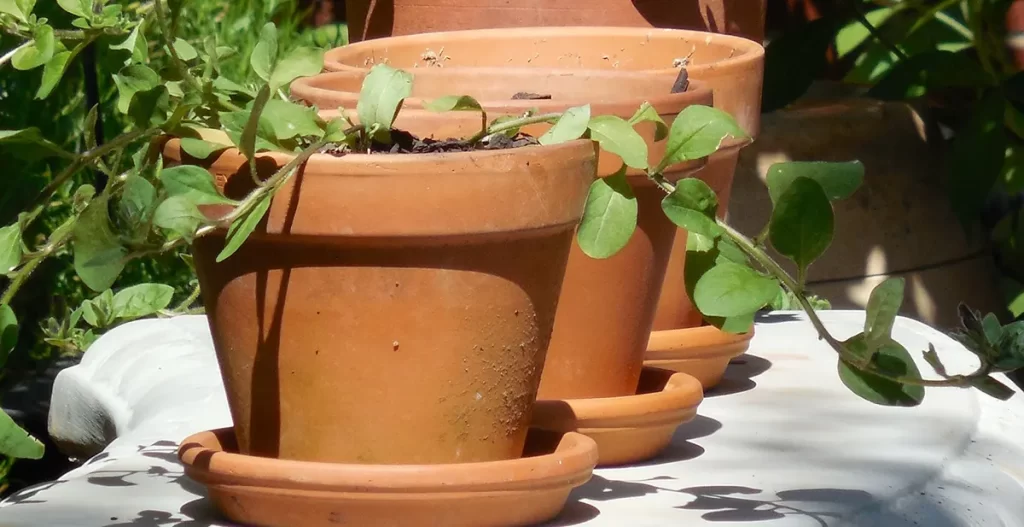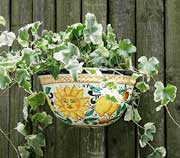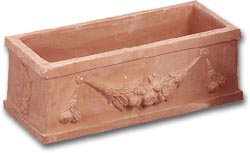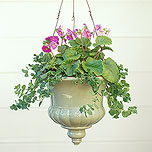
Clay Planters ~ earthenware, stoneware & terracotta planters
Shopping for clay planters can be a confusing task. You will find clay pots referred to as terracotta or stoneware or earthenware and sometimes, ceramic. There are distinct differences between each type that are very important to know when choosing planters for your outdoor decor.
Clay is the raw material of all ceramics, derived from a decomposed rock similar to granite. In its natural state, clay is soft when wet, crusty and brittle when dry. When baked in a high-temperature oven it becomes hard and strong. It is after this firing process that differences among various types of clay become most apparent.
Clay that has been fired (baked in a special oven called a ‘kiln’) to a temperature between 2050 – 2400 will ‘vitrify’—or become impervious to water. At this high temperature, the clay cells have bonded together like glass to prevent absorption of water.
A second characteristic that varies, is whether or not the clay pot is glazed or not glazed. This is not always as obvious as you might think. While a glassy surface is a sure sign a piece is glazed, some glazes that are transparent and not glossy can be difficult to detect on certain clays. In addition, some pottery manufacturers use a silicone coating which can act like a glaze, but is not ‘fired’ on the pot.
Let’s explore the differences so you can make the best selection when purchasing clay planters.
Earthenware Planters
 The term earthenware refers to clay pottery that has been fired to a relatively low temperature (1740 – 2100° Fahrenheit). It remains porous and permeable, so it will still absorb water if not glazed. Earthenware planters absorb moisture from the potting soil, so they must be carefully monitored in hot weather to ensure they do not dry out. It is also a good idea to pre-soak unglazed earthenware prior to planting.
The term earthenware refers to clay pottery that has been fired to a relatively low temperature (1740 – 2100° Fahrenheit). It remains porous and permeable, so it will still absorb water if not glazed. Earthenware planters absorb moisture from the potting soil, so they must be carefully monitored in hot weather to ensure they do not dry out. It is also a good idea to pre-soak unglazed earthenware prior to planting.
Earthenware may be glazed or unglazed, and is usually, but not always, buff, red, or brown in color. Red earthenware is a clay given its color by the presence of iron oxide. Earthenware planters are often glazed only on the outside, leaving the inside and bottom unglazed. Check your earthenware planters carefully before planting to identify how much water they will absorb.
Earthenware is also relatively soft and easily broken. Because earthenware can absorb water, it will crack or break if it freezes. Store your earthenware clay planters out of extreme weather to avoid damage from the cold.
Terracotta Planters
 Terracotta is earthenware made from a clay with a high iron content, which give it a characteristic reddish cast. Terracotta planters are typically not glazed, but new manufacturers are adding a silcone coating to seal the terracotta clay to reduce water absorption and damage from cold weather.
Terracotta is earthenware made from a clay with a high iron content, which give it a characteristic reddish cast. Terracotta planters are typically not glazed, but new manufacturers are adding a silcone coating to seal the terracotta clay to reduce water absorption and damage from cold weather.
Terracotta has been used to create containers, statues and tiles dating probably from 3000 BC. It was likely the accidental dropping of a hand-formed clay piece into a fire was the first piece of terracotta as we know it. Terracotta was very popular in Italy and Greece in the production of pots and containers for plants. Artisans carved intricate patterns and decorative elements in clay before firing to create the ornate terracotta urns and planters we love in our gardens today.
Natural salts within the terracotta clay may gradually seep through the clay to the exterior surface creating a whitish dust finish (often seen on plain terracotta pottery). This is quite normal and all terracotta must “breathe”. If undesired you can simply wash away the salts or allow the rain to do the job!
Impruneta terracotta planters from Italy are considered one among the best terracotta planters available.
Stoneware Planters
 Stoneware, is noticeably stronger, and usually also heavier than earthenware. Fired at higher temperatures than earthenware, it is typically glazed with a glassy color glaze and often given a decorative design or pattern.
Stoneware, is noticeably stronger, and usually also heavier than earthenware. Fired at higher temperatures than earthenware, it is typically glazed with a glassy color glaze and often given a decorative design or pattern.
Although stoneware is stronger and more durable than earthenware, it is still fragile and stoneware clay planters must be handled carefully to avoid chipping or breaking. Glazed stoneware may also be damaged in extremely cold weather if the glaze is not completely bonded to the clay. As with most earthenware and terracotta planters, it is best to store stoneware and ceramic planters indoors through the colder season.